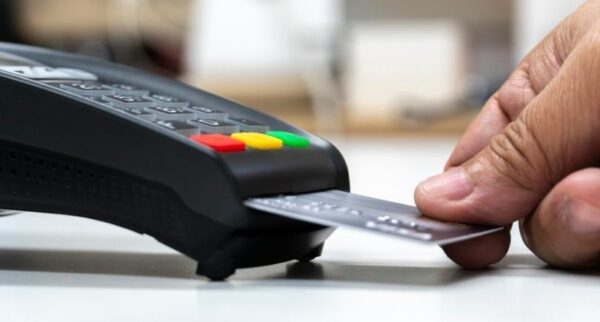
Why you should trust CardRatings.com
At CardRatings.com we discuss the most up-to-date news and trends within the credit card space. Since we first pioneered the concept of online credit card reviews in 1998, our team of financial experts has provided comprehensive and unbiased credit card reviews for more than 175 cards, plus hundreds of additional resource articles to help educate everyday cardholders so they can feel more confident about their card choices. All our content is written and reviewed by industry experts. Though our content may occasionally contain references to products from our partners, we maintain strict editorial integrity and advertiser relationships and compensation never influences ratings, reviews or featured products. The difference between editorial content and advertising must always be clearly stated. Learn more.
You may be looking for a credit card that offers cell phone protection, and for good reason. Smartphones need a lot of protection – from us.
As you may know from your own experience, or from hearing from family or friends, cell phones often come to a premature end at our own hands. We drop cell phones. We sometimes drop them in the bathtub, or the toilet. We get food and drinks on them. Some people probably get angry at them and possibly damage them. Things happen. Fortunately though, if you do damage your cell phone, or if it’s stolen, increasingly, you can contact your credit card issuer for help.
Obviously, when it comes to choosing a credit card, you want to look at the entire package that comes with the card – from the interest rates to the card’s rewards program. One good perk alone generally isn’t reason enough to get a certain credit card; however, if you’re considering a credit card with cell phone protection, this is definitely an amenity worthy looking further into.
Here’s a rundown of what you need to know, as well as a list of some credit cards with cell phone protection plans.
What is credit card cell phone protection?
Credit card cell phone protection is cell phone insurance offered as a perk by some credit cards. If something bad happens to your phone, assuming your situation falls in the guidelines that the credit card company has set out for you (like paying your monthly cell phone bill with your credit card), your credit card cell phone insurance will assist with the cost to get your phone fixed or replaced. Just like other insurance plans, coverage terms will vary by credit card.
How does credit card cell phone protection work?
In most, if not all cases, credit card cell phone insurance reimburses you if your cell phone is stolen or if it becomes damaged in some way. A small deductible is usually required with each claim, and the amount of coverage offered with each claim is usually capped at around $600. This varies by credit card, but $600 seems to be the common cap amount.
Does free cell phone insurance cover all types of cell phones?
Yes. As long as the cell phone insurance comes with your credit card, and you pay the phone bill with your credit card, you should be covered for any phone – and multiple phones. For example, if you’re paying for your cell phone bill but also your spouse and kids’ phones, and it’s your kid’s cell phone that is stolen or winds up with a cracked screen, that should all be covered.
Credit cards with cell phone protection
The best credit cards for cell phone protection are the ones, as you can probably imagine, that offer primary protection for the cell phone. In other words, with a credit card like the CardName the cardholder doesn’t have to first make a claim through another insurance policy, like their homeowners insurance.
All of that said, you shouldn’t get too distracted by a perk like cell phone insurance. It’s a helpful, great amenity, but it isn’t like you’re planning on having your cell phone damaged or stolen. You’ll want to look at other factors as well, like the cash back rewards that may or may not come with the credit card. You’ll also want to eye the welcome offer and analyze whether it’s worth paying an annual fee. If you find a cell phone with excellent cell phone protection, that’s just icing on the cake.
All of that said, here are some of the best credit cards for cell phone protection…
CardName
You’ll get up to $800 per eligible claim and $1,000 a year in cell phone protection against covered theft or damage for your phones. Just make sure you pay your monthly bill with your card, of course. You can do a maximum of two claims in a 12-month period with a $50 deductible per claim. Information related to Chase Freedom FlexSM has been collected independently by CardRatings and was neither reviewed nor provided by the card issuer
CardName
discontinued When you pay your monthly wireless bill with your card, your cell phone is protected for the next calendar month. So, you can get reimbursed if your cell phone is stolen or damaged ($50 deductible).
CardName
You can be reimbursed for your cost to repair or replace your stolen or damaged cell phone for a maximum of $800 per eligible claim with a limit of two approved claims per 12-month period. A $50 deductible will apply to each approved claim. As with all of these cards, you need to pay your cell phone bill with the card offering coverage. American Express is a CardRatings advertiser.
CardName
You’ll be reimbursed up to $600 for eligible damage or theft of your phone. (If you lose it, you are not covered.) You’ll have only a $25 deductible to pay, and you can make two claims a year.
CardName
Phone stolen? Damaged? You’re covered up to one claim a year, up to $600. There is a $100 deductible to fork over first, though, and this is supplementary, or secondary insurance, and so you’ll have to first put a claim through another insurer, if something else, like homeowners insurance, would also cover the damage or theft of your phone.
CardName
You and employees are covered up to $600 a claim with this supplemental cell phone insurance, and you’re allowed three claims a year, up to $600 per claim with a $1,800 maximum every 12 months. There is a $100 deductible.
CardName
You’ll get coverage up to $600 per eligible claim for damage or theft, and you can make up to two claims a year, although there’s a limit of up to $1,000 in those 12 months. There’s a $50 deductible, and this is secondary insurance, also known as supplemental insurance.
CardName
If you’re noticing a trend of cards either offering $600 or $800 in protection per claim, you wouldn’t be wrong. In this case, you could be reimbursed you up to $800 per eligible claim towards repairing or replacing your phone. In the event that things go wrong with your phone, including something like a cracked screen, you get two claims per year, and each time, you’ll pay a $50 deductible.
CardName
It’s unusual for secured credit cards to offer many perks, yet alone a perk this useful. Sable provides coverage in the event your covered cell phone is stolen or damaged (including cracked screens!) if your cell phone bill is charged to your credit card.
How does credit card cell phone insurance compare to AppleCare+?
Credit cards and AppleCare+ will each reimburse you for things that go wrong with your iPhone, but in the case of the cell phone protection that you get from your credit card, you’re getting reimbursed without paying anything, other than (if you file a claim) a deductible, which might be as low as $25 or as high as $100 ($50 is also common). With AppleCare+, you might be spending $199 or even $299 a year. How much you pay depends whether you want coverage for accidental damage or also coverage for loss and theft.
And, of course, if nothing goes wrong with your iPhone, and you don’t use AppleCare+, you don’t get your money back. That isn’t to suggest AppleCare+ isn’t a worthwhile expense. For some people, absolutely. But cheap, it isn’t.
What you need to know about credit card cell phone protection
If you are thinking about getting a credit card with cell phone protection, and you want it to be a good experience, keep the following rules in mind:
- Pay your cell phone bill with your credit card. We’ve said this before, but it bears repeating: the protection generally only kicks in if you’re paying your cell phone bill with your credit card. If you’re doing an automatic withdrawal from your checking account to pay for your cell phone, and your cell phone is stolen or damaged, you’ll be the one replacing your phone – not your credit card insurance.
-
Cell phone protection probably won’t cover lost phones. Your credit card probably won’t replace your cell phone if you lose it. Theft, yes. Damaged phone, yes. Lost? Probably not.
It makes sense that a lost phone wouldn’t be covered. Generally, credit cards will require that you file a police report for a stolen phone. If your phone is damaged, you can demonstrate to your credit card issuer proof of a damaged phone, unless you damage it and then throw it away (so don’t do that). But if you lose your phone, there’s rarely going to be proof that it’s actually lost. Heck, you could find your cell phone in some nook or cranny of your home the day after you get a replacement. If credit cards offered protection for people who lost phones, anyone could theoretically toss theirs in the trash and call their credit card company and say, “Gee, I somehow misplaced my phone. I’d like a new one, thank you…”
- These credit card cell phone protection plans are often supplemental insurance plans. Credit card cell phone insurance is usually supplemental coverage, meaning protection doesn’t kick in if the damage or theft could otherwise be covered by another insurance policy such as cell phone insurance programs or your homeowner’s, renter’s, automobile, or employer’s insurance policies. Supplemental insurance is usually only applied after all other insurance is exhausted.
- You’ll receive the value of your original phone or a comparable replacement. In other words, as you’ve probably guessed, if you bought a cell phone for $400, you won’t get $1,000 to buy the latest model. You’ll receive $400. Most cell phones these days pay around $600 to $800 per claim.
- You might save money with your credit card cell phone protection. If you’re already paying for cell phone insurance coverage and then get a credit card offering cell phone protection, you could eliminate the cost of your monthly insurance payments that you’ve been paying to your cell phone carrier from your budget. Typically that’ll run you about $5 to $20 a month, but if your household has multiple phones, and you were paying for cell phone insurance, getting rid of it and using your credit card’s cell phone protection plan instead should help your monthly budget.
- Protection isn’t unlimited. In every case we found, the protection is limited to a certain number of claims (often two) per year as well as a total payout annually (often up to $1,200). In other words, “accidentally” smashing your cellphone every time a new version hits the market could very well backfire – plus, remember you’ll only be reimbursed the value of your existing phone, not the value of a brand new phone (See Rule 4).
-
Read the fine print very carefully. You may have a family with, say, two adults and four phone-wielding kids. That doesn’t mean all six of your phones are covered. Your credit card may only cover two or three of them, and your plan probably doesn’t cover prepaid cell phones.
In fact, you really want to scrutinize the fine print. Generally, credit cards are looking to offer protection from garden variety thefts and damage. For instance, they may not cover theft if the phone was taken from your luggage stowed in the baggage compartment of the plane (that, though, might fall under the travel insurance offered by some credit cards), but they might cover it if your phone was in your hand-held carry-on.
Was your phone in a home that was damaged by a flood, hurricane or some other natural disaster? It may not be covered. And then again, it may be. Check that fine print.
What’s not covered in credit card cell phone insurance?
Unfortunately, the list can be kind of long. Generally, you’ll be covered if your phone is damaged or stolen. But some credit cards even put restrictions on that. Here are a few examples of instances where you probably won’t get compensation if something goes wrong with your phone.
- Stolen at an airport. Believe it or not, some credit cards have restrictions about cell phones being stolen out of checked baggage at the airport. If that happens to you, you likely won’t get reimbursed.
- If you lose your phone. This one bears repeating. If you lose your phone, you likely aren’t eligible for coverage. This is probably because insurers don’t want a lot of people who simply want a new phone for free, calling them up and saying, “Hey, I lost my phone.” But it does mean that if you’re going to an amusement park or a public restroom or wherever, hang onto that phone. Don’t set it down and forget about it.
- You lost your temper. And while boiling mad, you threw your phone at a tree. Feel better? Good. Is your phone in a million pieces? Get some exercise, pick up the pieces of your shattered screen, and go buy a new one. Unfortunately insurance probably doesn’t have your back in this situation.
- You had financial losses in a cyberattack on your cell phone. Here’s the good news. Many credit cards will reimburse you if hackers somehow get into your phone and make it inoperable. But if you lose a multi-million-dollar business account because you couldn’t get to your phone to make a deal, or due to the attack, your bank account is drained, you won’t get reimbursed for those financial losses. But your cell phone insurance will likely at least give you a new phone.
What if my credit card doesn’t offer cell phone protection?
As noted earlier, you want to look at all of a credit card’s perks and benefits and not just zero in on one. You may decide that a credit card you like that doesn’t offer cell phone protection is better for you. That said, don’t assume that your credit card without cell phone protection won’t still offer some protection for your cell phone. It just might – through your card’s new purchase protection, for instance. You might be able to get your phone replaced within that first 12 months if something goes wrong.
Or if your credit card offers an extended warranty, you might be able to get an extra year of coverage for free, beyond the cell phone’s own warranty (if there is one).
But, of course, to do that, you need to have bought your cell phone with your credit card (as opposed to cash, a debit card or another credit card without the new purchase protection or extended warranty program). You’ll also want to save your receipt and the product’s warranty paperwork. And then if something does go south with your cell phone, even without official cell phone protection, you know who to call (but you may have to use a landline).
Is it worth it to have cell phone insurance?
Yes, especially when it’s cell phone insurance that you receive with a credit card. Whether or not you should pay for cell phone insurance is another debate, but if you have a credit card that offers cell phone insurance, and all you have to do is use your credit card to pay for your monthly bills, in order to get the insurance, it’s a no-brainer. In that case, it’s definitely worth it to have cell phone insurance.


